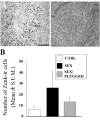The underestimated role of olfaction in avian reproduction?
- PMID: 18804490
- PMCID: PMC2692081
- DOI: 10.1016/j.bbr.2008.08.036
The underestimated role of olfaction in avian reproduction?
Abstract
Until the second half of the 20th century, it was broadly accepted that most birds are microsmatic if not anosmic and unable to detect and use olfactory information. Exceptions were eventually conceded for species like procellariiforms, vultures or kiwis that detect their food at least in part based on olfactory signals. During the past 20-30 years, many publications have appeared indicating that this view is definitely erroneous. We briefly review here anatomical, electrophysiological and behavioral data demonstrating that birds in general possess a functional olfactory system and are able to use olfactory information in a variety of ethological contexts, including reproduction. Recent work also indicates that brain activation induced by sexual interactions with a female is significantly affected by olfactory deprivation in Japanese quail. Brain activation was measured via immunocytochemical detection of the protein product of the immediate early gene c-fos. Changes observed concerned two brain areas that play a key role in the control of male sexual behavior, the medial preoptic nucleus and the bed nucleus of the stria terminalis therefore suggesting a potential role of olfaction in the control of reproduction. The widespread idea that birds are anosmic or microsmatic is thus not supported by the available experimental data and presumably originates in our anthropomorphic view that leads us to think that birds do not smell because they have a rigid beak and nostrils and do not obviously sniff. Experimental analysis of this phenomenon is thus warranted and should lead to a significant change in our understanding of avian biology.
Figures




Similar articles
-
The perfume of reproduction in birds: chemosignaling in avian social life.Horm Behav. 2015 Feb;68:25-42. doi: 10.1016/j.yhbeh.2014.06.001. Epub 2014 Jun 11. Horm Behav. 2015. PMID: 24928570 Free PMC article. Review.
-
Pheromones in birds: myth or reality?J Comp Physiol A Neuroethol Sens Neural Behav Physiol. 2010 Oct;196(10):751-66. doi: 10.1007/s00359-010-0534-4. Epub 2010 May 21. J Comp Physiol A Neuroethol Sens Neural Behav Physiol. 2010. PMID: 20490809 Free PMC article. Review.
-
Site-specific effects of anosmia and cloacal gland anesthesia on Fos expression induced in male quail brain by sexual behavior.Behav Brain Res. 2008 Dec 1;194(1):52-65. doi: 10.1016/j.bbr.2008.06.022. Epub 2008 Jun 28. Behav Brain Res. 2008. PMID: 18638505 Free PMC article.
-
Could osmotaxis explain the ability of blue petrels to return to their burrows at night?J Exp Biol. 2001 Apr;204(Pt 8):1485-9. doi: 10.1242/jeb.204.8.1485. J Exp Biol. 2001. PMID: 11273809
-
Understanding smell--the olfactory stimulus problem.Neurosci Biobehav Rev. 2013 Sep;37(8):1667-79. doi: 10.1016/j.neubiorev.2013.06.009. Epub 2013 Jun 25. Neurosci Biobehav Rev. 2013. PMID: 23806440 Review.
Cited by
-
Mutual influences between the main olfactory and vomeronasal systems in development and evolution.Front Neuroanat. 2012 Dec 24;6:50. doi: 10.3389/fnana.2012.00050. eCollection 2012. Front Neuroanat. 2012. PMID: 23269914 Free PMC article.
-
Chemical composition of preen wax reflects major histocompatibility complex similarity in songbirds.Proc Biol Sci. 2016 Nov 16;283(1842):20161966. doi: 10.1098/rspb.2016.1966. Proc Biol Sci. 2016. PMID: 27807264 Free PMC article.
-
Sexual arousal, is it for mammals only?Horm Behav. 2011 May;59(5):645-55. doi: 10.1016/j.yhbeh.2010.11.001. Epub 2010 Nov 9. Horm Behav. 2011. PMID: 21073874 Free PMC article. Review.
-
Exploiting common senses: sensory ecology meets wildlife conservation and management.Conserv Physiol. 2021 Mar 29;9(1):coab002. doi: 10.1093/conphys/coab002. eCollection 2021. Conserv Physiol. 2021. PMID: 33815799 Free PMC article.
-
Odour-based natal nest recognition in the zebra finch (Taeniopygia guttata), a colony-breeding songbird.Biol Lett. 2011 Apr 23;7(2):184-6. doi: 10.1098/rsbl.2010.0775. Epub 2010 Sep 29. Biol Lett. 2011. PMID: 20880859 Free PMC article.
References
-
- Amo L, et al. Predator odour recognition and avoidance in a songbird. Functional Ecology. 2008;22:289–293.
-
- Ball GF, Tlemçani O, Balthazart J. Induction of the Zenk protein after sexual interactions in male Japanese quail. Neuroreport. 1997;8:2965–2970. - PubMed
-
- Balthazart J, Schoffeniels E. Pheromones are involved in the control of sexual behaviour in birds. Naturwissenschaften. 1979;66:55–56. - PubMed
-
- Balthazart J, Absil P. Identification of catecholaminergic inputs to and outputs from aromatase-containing brain areas of the Japanese quail by tract tracing combined with tyrosine hydroxylase immunocytochemistry. J Comp Neurol. 1997;382:401–428. - PubMed
Publication types
MeSH terms
Grants and funding
LinkOut - more resources
Full Text Sources
Miscellaneous

